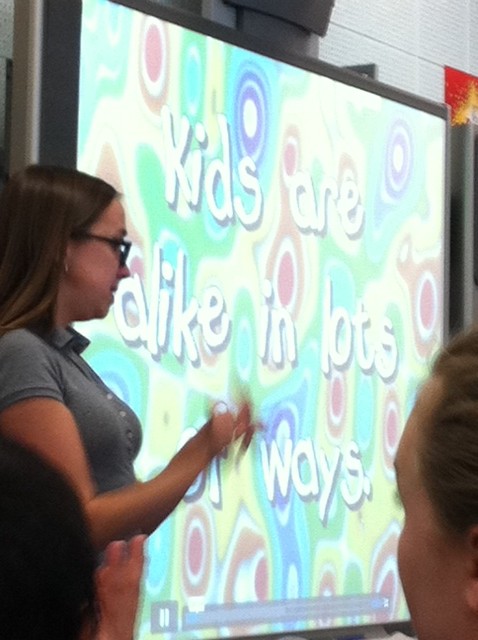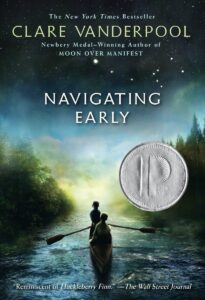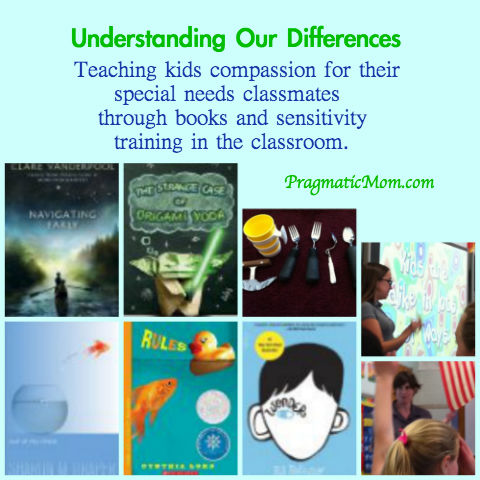I volunteered in the 5th grade a few weeks ago for a really great program run by volunteer moms called Understanding Our Differences. I believe we purchase a curriculum from a Newton-based non-profit with the same name which was started by a Newton parent with a special needs child. It’s basically sensitivity training for grades 3 through 5, possibly even younger.
Understanding Our Differences Makes a Difference
Understanding Our Differences sponsored author R. J. Palacio of Wonder as well to speak at our local high school as well and I run into them on Twitter. Small world, isn’t it?
I am not a coordinator. I just show to help run the breakout sessions. This was the final session for the 5th graders and we combined in two units that day: Physical Disabilities and Autism Spectrum Disorders, focusing on Asperger’s Syndrome.
It took about 2 1/2 hours to do both units. There is a presentation by the mom coordinator who gives an overview of the unit. This is followed by a short film and then hands-on break-out sessions. The final piece is having Special Need high school students present as a panel. They each will have a short speech and then take questions. It’s really amazing to have those high school kids present. It brings it all home in a really meaningful way.
One big takeaway message is finding more similarities than differences. There was also a person who signed the presentation. The video showed a young paraplegic man who used amazing computer technology to live and work independently.
Teaching Kids about Physical Disabilities
The first breakout session was looking at adaptive technologies for those with physical disabilities. The kids could hold the object and guess how it worked.
The grabber claw was especially popular and amazingly versatile with the ability to pick up very small and slippery objects.
Teaching Kids About Asperger’s Syndrome
The second presentation for Asperger’s Syndrome had two interesting challenges. My group had 5 minutes to do this worksheet while exposed to extremely loud and disruptive noises. No one was able to complete the worksheet. The other group had to do a 50 piece puzzle with limited ability to communicate.
Does this training work? The proof was in the panel of five high school kids who have Asperger’s Syndrome. One of the boys said he was in this very same Understanding Our Differences training on Asperger’s Syndrome seven years ago when he was a 5th grader. The atmosphere felt encouraging so he raised his hand and told all his classmates that he had just been diagnosed with Asperger’s Syndrome. The result was that he had a relatively smooth transition to middle school and high school. Kids stood up for him when he was bullied. They were also more patient with him since they understood, just a little, of what life was like for him. The others weren’t so lucky and their middle school experience was more isolating.
I don’t know how the program works if you are interested in it for your school but you can go here for more information. If your school’s budget can’t swing it, I would also suggest books with special needs characters as a way to teach typicals compassion for their special needs classmates.
Teaching Kids Compassion Through Chapter Books
Strange Case of Origami Yoda by Tom Angleberger
It’s not clear but it’s possible that Dwight has Asperger’s Syndrome. He’s strange and kids avoid him or tease him until they realize that he dispenses wise advice that he can’t seem to follow himself using a paper origami Yoda puppet. Dwight’s classmate Tommy creates a case file with contributions from his 6th-grade classmates to understand if Yoda is a true wonder or just a coincidence. [middle grade, ages 7 and up]
Wonder by R.J. Palacio
“If every person in this room made it a rule that wherever you are, whenever you can, you will try to act a little kinder than is necessary – the world really would be a better place. And if you do this, if you act just a little kinder than is necessary, someone else, somewhere, someday, may recognize in you, in every single one of you, the face of God.”
― R.J. Palacio, Wonder
It’s no wonder that Wonder was chosen by Understanding Our Differences for an author event! [middle grade, ages 8 and up]
Out of My Mind by Sharon M. Draper
11-year-old Melody has Cerebral Palsy so she can’t walk or talk and has to depend on assistance to do basic things like eating. But she also has a photographic memory that isn’t so obvious. Her classmates and most adults don’t realize how smart she is. Will an academic competition finally prove to the world that she’s not academically challenged? [middle grade, ages 8 and up]
Navigating Early by Clare Vanderpool
Vanderpool doesn’t say what special needs Early has but it’s possible that he has Asperger’s Syndrome. He makes an unlikely friendship with Jack who joins his military boarding school in Maine after Jack’s mother dies. Together, they set off on an adventure tracking a bear, following a story of Pi, and finding their footing in an ever-changing world. [middle grade, ages 8 and up]
From Ink and Pen: 5 YA Characters with Aspergers
p.s. I had included Rules by Cynthia Lord but Ettina enlightened me with this review of Rules from Disability in KidLit. Thank you for helping me overcome my ignorance.
Disability in KidLit Review of Rules by Cynthia Lord
“Throughout the book, Catherine talks about wishing she had a normal brother—wishing David wasn’t autistic. The way this is written, along with Catherine’s constant use of rules in an effort to change David, is alarming. With a constant focus on the need for a “cure” for autism, something myself and a large portion of the autistic community is against, the usage of this in a children’s book honestly scares me. Rather than promoting acceptance, this is showing that autistics need to be changed or cured.”
What if your brother is severely Autistic such that he always stands out? 12-year-old Catherine wants a normal life, just once. Twelve-year-old Catherine just wants a normal life so she teaches her brother rules to fit in better. But when she meets Jason, a new friend/boyfriend?!!, his physical disabilities are both a bridge and a barrier. Will her best friend Kristi understand? [middle grade, ages 8 and up]
p.s. Related posts:
15 #OwnVoices Books about Autism
Book Lists to Teach Kids Compassion
Lynda Mullaly Hunt Author Visit: Fish in a Tree
Wonder by Palacio is Wonderful for Teaching Kids Compassion
Diversity, Inclusion & #Activate4Autism Movement
Gift Ideas for Children with Autism
Picture Book about Autism for Typicals in Elementary School
Support a Voice Actor on the Spectrum
5 STEM Picture Books Celebrating Differences
Wonder by R J Palacio Helps Us Understand Our Differences
How To: Teach Your Children About Islam (and tolerance in the process!)
To examine any book more closely at Amazon, please click on image of book.
As an Amazon Associate, I earn from qualifying purchases.
BEST #OWNVOICES CHILDREN’S BOOKS: My Favorite Diversity Books for Kids Ages 1-12 is a book that I created to highlight books written by authors who share the same marginalized identity as the characters in their books.



















I just finished “Out of my Head” . It was a terrific book about a girl with MS and how she would get dismissed because people didn’t look beyond the disability. Great YA book that was perfect for discussion.
Hi Carole,
My 5th grader loved that book too. I should have included it too. Thanks for your great suggestion!!
This training is a marvelous idea. Both parents and children need to be aware. It is so much easier to criticize and make fun of what we don’t understand. Walk a mile in my shoes goes a long way in mitigating the problem.
Hi Barbara,
That’s exactly right, Walk a Mile in My Shoes was so meaningful to everyone who experienced it. Especially having a panel of students from high school speak and take questions. That is always the most powerful part of the presentation.
This program sounds great! I just finished (and really enjoyed) Navigating Early – thanks for the recommendation!
Hi MaryAnne,
So glad you liked Navigating Early! You probably already enjoyed her first book, Moon Over Manifest, that won the Newbery? Pretty impressive works for her first two books, isn’t it? And she wrote these books while parenting 4 kids (but they are older now). She’s pretty amazing!
I think this is a great idea too and it is always nice to follow up with reading.
Thanks Ann,
My middle daughter really likes books with special needs characters. When the story is sad, she feels empathy which we are hoping carries over to real life. I think it does though. We were recently at the airport to Florida and we saw her classmate with Downs Syndrome who loves her. She has been really patient with him even when he licks her face (and she would not tolerate that from anyone else, believe me!). He talked about seeing her a lot afterwards and she was really patient about that which made me so happy because patience does not come naturally to her.
I wonder how well we can teach about disabilities through books. I have a friend that adopted a little boy with cerebral palsy years ago (she already had 7 of her own) He ended up going to a regular mainstream school ( a boys yeshiva actually) and it was amazing how the kids accepted him and took him in. That was real life though.
Hi Faigie,
I like the combination of a special program to teach kids about Understanding Our Differences and books to help kids walk a mile in their shoes. I do think books are powerful to put kids into a different perspective from what they know. How great that your friend’s little boy is accepted at his new school. I’m so glad!
Special needs children are really discriminated against especially if they are attending mainstream schools. To a larger extent, teachers are to blame because they really don’t teach other children how to handle them. This is a very nice post.
Hi Viren,
I do think that having special programs for teachers or volunteers to run helps everyone. I think it’s tough to develop the curriculum on your own as a teacher. It really does take special knowledge and props to send the message home. I’m glad you liked the post. Thanks so much for your kind words!
It is brilliant to hear experiences such as this and such positivity.
Hi Pickoddy,
It made me really happy to see that the kids get this kind of experience and it’s a great reference point when they need to draw upon their empathy skills.
My son is reading the Origami Yoda books right now. I still have to read Wonder!
Hi Erica,
What does your son think of the Origami Yoda series? My son really liked them. He hasn’t read Wonder yet, but my 5th grader thought it was one of best books she’s ever read.
clive essame • I have just published Impisi, my first book. It is a story about how society sees people who are different – through physical disability, appearance – and is told entirely through the characters of African wild animals. Nkosi the lion is about to take over the pride until he is caught in a wire snare. He escapes but is permanently disabled. He sinks to the depths of despair, self pity, ridiculed by other animals until help comes along in a very unexpected way. Impisi has been performed as a play in South Africa and is now available as an ebook through Kindle and a play script for schools, colleges and drama companies. It is story told through humour, drama and compassion and because it works on many different levels is suitable for readers and audiences from about 8 upwards. Please take a look at impisi.com
From my LinkedIn Group Elementary School Teachers of America
Thanks for the heads up on your book Clive. I will post your comment to my blog so my readers will know about it.
I have a fourth grade class, with whom I spend most of the day, and a sixth grade history group.
Sometimes you can get at the compassion issue obliquely by explaining how differently we treat the handicapped today through history lessons about the unkind practices of ancient societies, or even the America of the 1800’s.
In other cases you need to have “the talk.”
Directions for this
Send the affected child to visit another classroom to help out for a bit.
State that we all I have problems. I confess that I (the person with all the math answers!) have so much trouble with directions that my own two-year-olds said, “Wrong way, Mommy!” as one of their first complete sentences
Remind the children that each and every one of them struggles with something and needs extra help occasionally. Reflect your pride that all of them have also been helpful to others
Tell them that our class is a family and that we are together to learn and to support each other.
Insist that your students will not tease each other or allow teasing in their presence.
Express confidence that such wonderful children will be kind. No need to say to whom.
After that, consistently praise the kind and detain the mean. This is what works for me.
From Kathleen M via my LinkedIn Group Elementary School Teachers of America
Thank you so much for sharing your wonderful ideas of how to teach compassion in the classroom Kathleen! I will post your comment onto my blog as well so that my readers can get your great ideas. Thanks again!
Rules is not a very respectful portrayal of autism, as the Disability in Kidlit website discusses.
David is treated as a plot device, not a person, and his parents and sister behave quite negatively towards him and don’t seem interested in learning how he communicates.
Thanks so much for pointing that out Ettina. I didn’t realize that. I’ll update my post with this information and find some alternatives.
Disability in KidLit Review of Rules by Cynthia Lord: http://disabilityinkidlit.com/2015/04/12/review-rules-by-cynthia-lord/
“Throughout the book Catherine talks about wishing she had a normal brother—wishing David wasn’t autistic. The way this is written, along with Catherine’s constant use of rules in an effort to change David, is alarming. With a constant focus on the need for a “cure” for autism, something myself and a large portion of the autistic community are against, the usage of this in a children’s book honestly scares me. Rather than promoting acceptance, this is showing that autistics need to be changed or cured.”